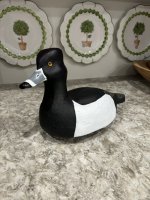As many know, I’m not a carver. I’m barely a decoy maker as I just started in February. So I’m literally a nobody in the game. Molding is my only way of making a decoy as I work 60 hours a week and have way too many hobbies in life. But I refuse to copy people and solely rely on my own processes. Of course I’ve gotten a lot of pointers and have had an incredible influence in Don with the air brushing. But all the molding and creative aspects are 100% from my brain. Don’t laugh, but these little cones I can get 50 for like $10. The pvc will make 40 decoys for $17. Im using 5oz of onyx per mold and I found a white version that is 1/3 the price of the black stuff. I’ve taken the time (and it’s been a process) to cast in onyx bills on all my heads, cast onyx tails on all my decoys, and cast my own cup for the stake to sit in. By doing it this way, I can use about 3 oz less foam when casting the decoy and I get just the slightest amount of foam slip under the cone. About 10 seconds with a dremel and I clear out the foam for the stake to go in. Theres been a lot of mold making to make all the pieces work, but I had 3 hours to work in the shop this weekend and I was able to make, and glue together, 18 feeder snows. Itll take me about an hour to put all the apoxie sculpt on and then will restle coat and hand paint flat white paint and black. If my math is correct, I’m able to make 2 dozen full body snows for ~$120-150. Most important part is that I truly believe I’m putting in the correct pieces for the decoy to last a good long time. As I’m pretty darn tough on my decoys, especially snow goose decoys.

